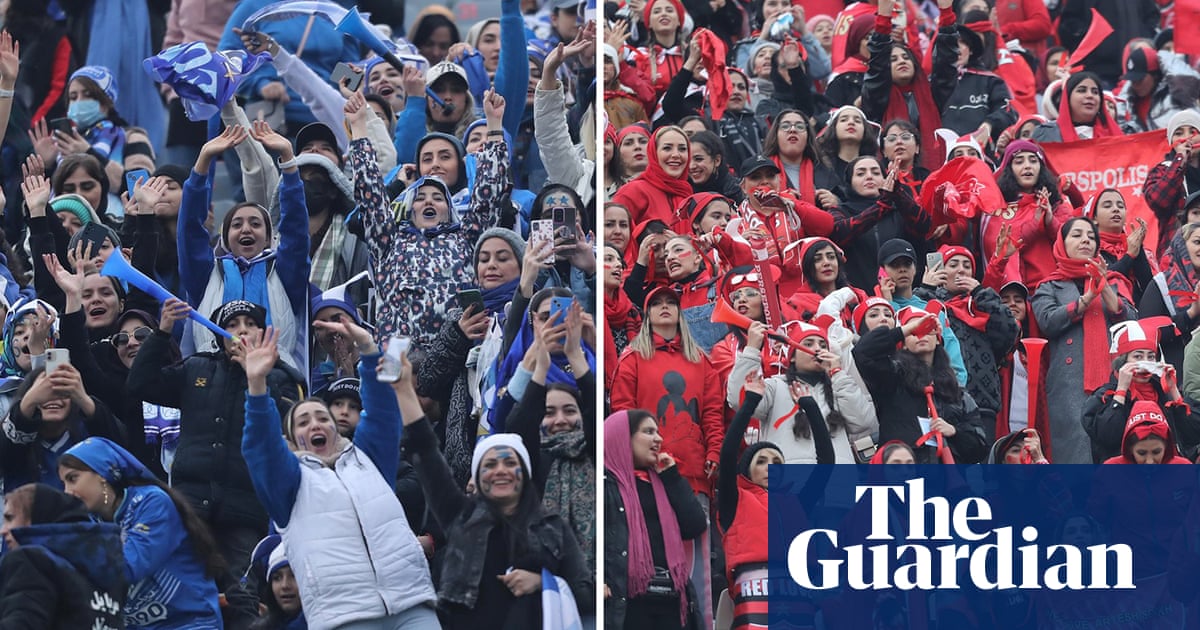
It’s been a long road from the Islamic Revolution in 1979 and the start of the ban on women from watching football at stadiums to allowing access to the female half of a football-loving population.
There is still far to go but in December steps were finally taken by 3,000 women to the upper tiers of the cavernous Azadi Stadium to watch the Tehran derby between the twin giants of Persepolis and Esteghlal.
“The general sentiment is ‘finally!’ This should have happened a long time ago,” Tara Sepehri Far of Human Rights Watch tells the Guardian. She pays tribute to the persistence of women as well as sports fans, teams and athletes. “Combined with Fifa’s pressing it made it much harder for authorities to justify this arbitrary and discriminatory ban.”
Open Stadiums, a movement of Iranian women which seeks to end discrimination, welcomed the move. “The opening of stadiums in Iran is a result of two decades of campaigning constantly against the regime and religious clerics who are anti-women’s rights,” Sara, not her real name, of Open Stadiums says. “It comes after lots of physical harassment and even the death of a female fan.”
Sahar Khodayari, AKA The Blue Girl, after the colours of her team Esteghlal, died in September 2019 with 90% burns. She set herself on fire outside a Tehran court upon learning she faced six months in prison. Her crime? Six months earlier, she had gone to the Azadi to watch her team play. But her disguise, meant to make her look like a man, did not work and she was arrested.
Her nickname does not do justice to her incredible bravery and the courage of others who just wanted to follow their passion even though it was, in Iran, a dangerous one. There was an outpouring of sympathy and support with players and clubs speaking out and fans, male of course, singing her name. In December, men and women sang together at the Azadi.
“This time we see in some stadiums there is a women’s section which means their presence is guaranteed,” Sara said. There is another development. “This time, they are also selling a number of tickets online.” In the rare occasions in the past when women were allowed in for national team games, they seemed to be handpicked supporters of the regime but if anyone can buy tickets online then anyone can go. “This part is really important because actual female fans can enter stadiums rather than women that are close to the FA.”
More needs to be done and Open Stadiums is not about to declare “mission accomplished” just yet. “The Iranian FA and the IRGC [Islamic Revolutionary Guard Corp] decide how many women can enter, there’s no specific logic behind it,” Sara says.
There had been intermittent pressure from Fifa in the past that has not always worked – in 2022 women were pepper-sprayed as they tried to watch the men’s national team in action – but Sara would like to see the world governing body use the federation’s need for money (because of international sanctions) as leverage to bring about faster and wider change.
So would Sepehri Far, noting that there have been reports in some areas of the country, such as in the city of Fuladshahr in November, of women not being admitted. “Fifa should keep pressing to make sure this is implemented across the country at all games and the quotas are not used to limit the attendance of women,” she says.
As well as the quantity – equal access to tickets for female fans – campaigners want more quality, too. Watch on domestic television and it is hard to see the new supporters as they are tucked away in corners away from the cameras.
“While people think it should have happened a while ago, now they are annoyed, especially in the Azadi Stadium,” Sara says. “Women are really far away, usually on the second tier and far away from the pitch, and they are also under the severe control of the ‘morality police’.”
Saudi Arabia allowed the entry of female fans in 2018 and now there are extensive family sections in most stadiums. “Saudi Arabia removing the ban made them [Iran] even more of an outlier on this issue,” says Sepehri Far.
Officials in Tehran deny that their softening has anything to do with Riyadh’s decision that left Iran as the sole country in which women were barred from watching the game. Family sections would be welcomed in the country, meaning families would not have to head in different directions once they arrive at the 78,000-capacity Azadi, for example.
“The stadium is really big and the west and east entrances are kilometres away from each other, and this makes a lot of inconveniences for families who have to be separated to enter the stadium,” Sara says. “There should be at least family sections so that people don’t get separated.”
Sara also wants the international media to keep paying attention to the plight of Iranian women. Their situation was in the spotlight for a while in 2022 with the nationwide protests that were led by women following the death of Mahsa Amini in police custody after she was arrested for allegedly wearing her hijab inappropriately.
“Imprisonment and execution continue as it is now not in the news. The regime really likes to play with news headlines and create a nice picture especially after the women’s uprising.”
Women in stadiums is a step forward but the struggle continues. “We fight this regime’s anti-human and anti-women’s rights behaviour every day” Sara says. “Nothing has really changed.”












